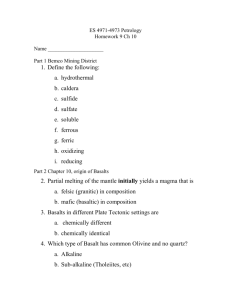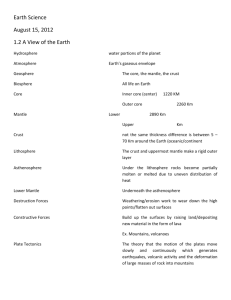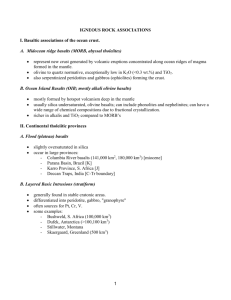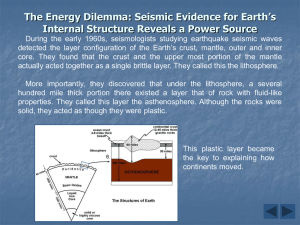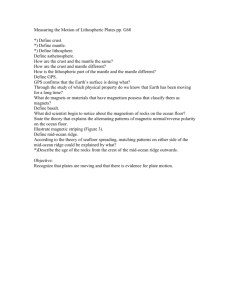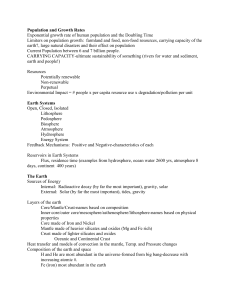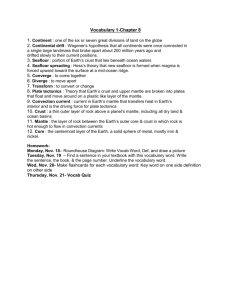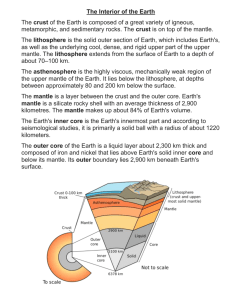Mantle and Basalts
advertisement
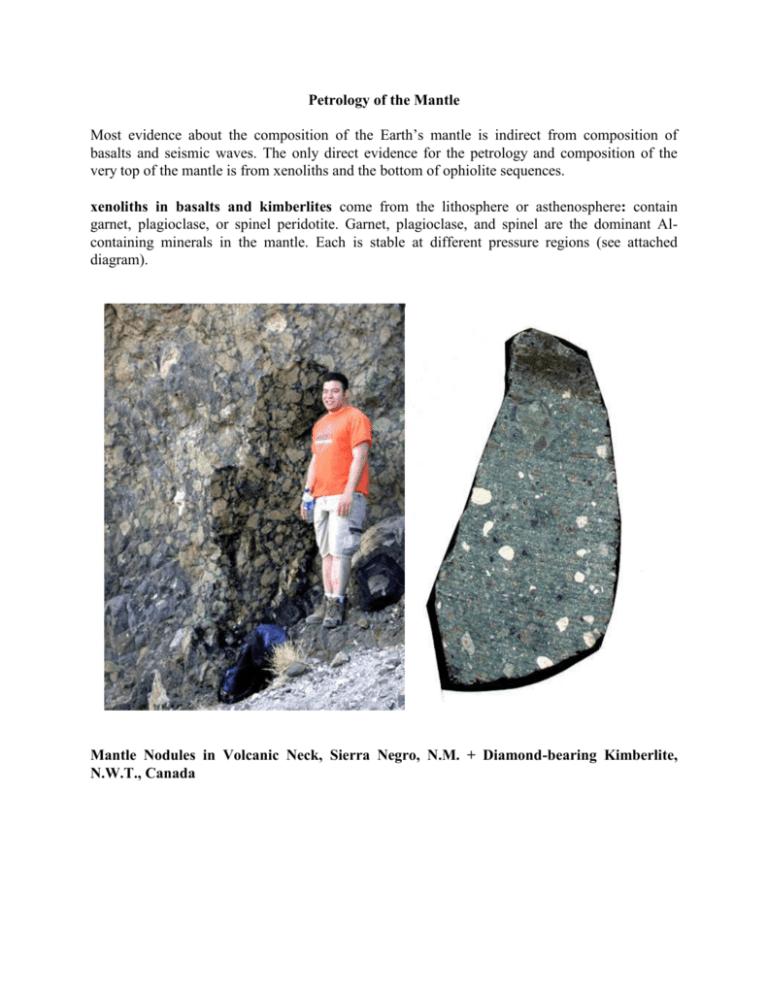
Petrology of the Mantle Most evidence about the composition of the Earth’s mantle is indirect from composition of basalts and seismic waves. The only direct evidence for the petrology and composition of the very top of the mantle is from xenoliths and the bottom of ophiolite sequences. xenoliths in basalts and kimberlites come from the lithosphere or asthenosphere: contain garnet, plagioclase, or spinel peridotite. Garnet, plagioclase, and spinel are the dominant Alcontaining minerals in the mantle. Each is stable at different pressure regions (see attached diagram). Mantle Nodules in Volcanic Neck, Sierra Negro, N.M. + Diamond-bearing Kimberlite, N.W.T., Canada Ophiolites – ocean crust obducted onto Continents during Continent-Continent Collision (e.g. Newfoundland) Seismic data lower crust: Vp = 6.6-7.0 km/s g/cc upper mantle lithosphere: Vp = 7.8-8.4 km/s g/cc (the crust and the upper mantle together are referred to as the lithosphere) asthenosphere (~60 to 150 km): Vp = 7.5-7.8 km/s; 3-5% velocity decrease >150 km velocity increases The velocity data correspond to garnet peridotite with ~ 63% oliv + 35% opx + 2% cpx + 10% garnet The major oxides are SiO2, MgO, FeO. Minor oxides are CaO and Al2O3. Other elements are in very minor to trace concentrations. The name given to the estimated original mantle composition is pyrolite: SiO2 45.9 TiO2 0.09 Al2O3 1.57 Cr2O3 0.32 FeO 6.91 MnO 0.11 NiO 0.29 MgO 43.5 CaO 1.16 Na2O 0.16 K2O 0.12 400 km seismic discontinuity The discontinuity is due to polymorphic transitions: i) olivine spinel structure (tighter structure with shared faces of polyhedrons) ii) pyroxene goes into a garnet structure: 2(Ca,Mg)2Si2O6 Ca,Mg)3(Mg,Si)2Si3O12 (majorite garnet with Si in octahedral coordination) 600 km discontinuity i) pyrope garnet ilmenite structure (all octahedral) ii) garnet, opx perovskite structure with all Si on octahedral coordination. (True perovskite is CaTiO3.) iii) spinel ilmenite structure + MgO below 1050 (all MgO, FeO and SiO2 are in octahedral coordination.) MAJOR IGNEOUS ASSOCIATIONS OF THE OCEAN FLOOR 1) Mid-ocean basalts/gabbros (MORB’s) 2) Ocean island basalts (OIB’s) These two magma series have differ primarily in the concentrations of minor elements, including K, Ti, U, Th, La, and other large-ion-lithophile trace elements. MID-OCEAN RIDGE BASALTS Characteristics: the major magma type is tholeiitic basalt slightly olivine to quartz normative (“basalt tetrahedron”) K2O < 0.3 wt.%, TiO2 < 2% (see table) 1, 2 – Olivine Basalt, 3,4,5,6 – Tholeiitic Basalt relatively low total alkalis (K2O + Na2O) for a given SiO2 or Al2O3 content include: a) “normal” N-MORB’s with <0.1% K2O, <1% TiO2, and very low concentrations of light rare earth elements (REE’s), such as La and Ce and other heavy elements, including U and Th and b) “enriched” E-MORB’s with >0.1% K2O, >1% TiO2 and are relatively enriched in light REE’s N-MORB’s are dominant at all mid-ocean ridges. They are generated below mid-ocean ridges from the depleted upper mantle source. E-MORB’s are represented by plumes centered on mid-ocean ridges. Examples include Iceland and the Azores. They are thought to be derived from plumes generated near the 650 km discontinuity, from either a) a distinct lower mantle source, or b) boundary source enriched by subducted ocean crust trapped at the discontinuity A major implication of the very low concentrations of alkali elements and most heavy, large trace elements (large-ion lithophile) in N-MORB’s is that the upper mantle is depleted of these elements. The extracted elements are now highly concentrated in the continental crust. Melting in the Upper Mantle Adiabatic melting It is important to recognize that although the upper mantle convects, it is not molten. Likewise, deep mantle plumes are rising portions of hot solid mantle. Deep plumes do not contain melt; they ascend by “creep”. Adiabatic melting occurs when rising mantle does not cool along the geotherm, but instead it remains hot. This allows it to reach the mantle solidus that has a shallower slope on the P-T diagram (see diagram below). The melting is eutectic involving olivine, opx, and cpx. The melting continues as long as the eutectic condition remains. The extra heat that the rising mantle carries is used for the necessary “heat of fusion”. Once cpx melts-out, the melting stops (see below). Phase equilibria The appropriate phase diagram for explaining the composition of MORB’s involves the major mantle phases olivine, orthopyroxene and clinopyroxene. The model diagram for this system is the front side of the basalt tetrahedron: The above diagram is for the Fe-free system. However, Fe is obviously very important in the mantle. To get the Fe/Mg ratios of the minerals in the mantle, we can use appropriate binary phase diagrams and the known Mg/(Mg+Fe) ratio, called the Mg#, of primary MORB’s which is ~0.70. For example, from the binary Mg2SiO4-Fe2SiO4 phase diagram we can figure out that mantle olivine must be Fo90. This is also confirmed by the fact that during crystallization of primary MORB’s, Fo90 is the composition of the first olivine. The diagram that illustrates phase relations during melting of the real Fe-containing mantle is the following one: Ca(Mg,Fe)Si 2O6 cpx cpx+L e o l 1 a tm + L opx+L 10 kb ar ol (Mg,Fe) 2SiO4 p opx qtz SiO 2 after Stolper, 1983 Note that as opposed the simplified diagram above, this one is in terms of mole%, not wt.%. The above diagrams shows two important things: 1) that the 1 atm. peritectic point becomes a eutectic with increase in pressure as the cpx-opx join becomes a thermal high. This involves something called the Alkemade line and the Alkemade theorem: Alkemade line joins composition of two primary phases whose primary crystallization fields are adjacent to a boundary curve separating the two phases. In the diagram below on the left, the opx-cpx join is not an Alkemade line, because it crosses the fo-di boundary, not the en-di boundary. In the diagram on the right, the join crosses the opx-cpx boundary, thus the join is an Alkemade line. Ca(Mg,Fe)Si2O6 cpx 1 atm cpx+L p ol+L opx+L ol (Mg,Fe)2SiO4 opx qtz SiO 2 Alkemade theorem states that “Direction of falling temperature on the boundary curve is away from the intersection of the boundary curve and its Alkemade line”. The implication is that what was before a peritectic now becomes a eutectic point and the Alkemade line is a thermal ridge on the diagram. 2) At high pressure, the composition of melts generated at the ternary eutectic has higher (Mg+Fe)/Si that for melts generated at shallow depths. Thus, melts generated at greater depth will tend to be olivine normative, whereas those generated at shallower depths will tend to be quartz normative. The Ocean Crust New ocean floor forms at the spreading ridge. The crust is generated from crystallization products of new basaltic magmas/lavas. The crust is 5 -10 km thick. We know what the crust looks like from its pieces that were obducted onto the continents. Such pieces of the crust are called ophiolites The ocean crust consist of a) b) c) d) e) cumulate products of crystallization within below-ridge mafic magma chambers differentiated gabbroic melts sheeted dikes pillow basalts (extrusive) sediments Sea-water circulation through the hot rocks is a major geologic activity at mid-ocean ridges. It results in: a) black smokers (massive sulfide deposits) b) ecosystems that rely of sulfur redox-reactions for their energy c) diagenetic alteration of the mafic minerals to serpentine and chlorite. OCEAN ISLAND BASALTS There are two principle basalt types on ocean islands: tholeiites and alkali olivine basalts. Both are generated by melting of a hot mantle plume that rises from the lower mantle. A volcanic ocean island usually forms in several stages: pre-shield stage: submarine eruption of alkali olivine basalts. This stage involves low degrees of melting (few percent) of the plume at great depths (~90 km?) shield-building stage: the most voluminous stage dominated by tholeiitic basalts. The basalts probably form at a shallower depth as the rising plume continues to melt along the mantle solidus as it rises. post-shield stage: again alkali olivine basalts. Generation of these basalts probably represents the last vestiges of melt as the plume ceases to actively generate melts for a brief period of time. The difference in the compositions of tholeiites and alkali basalts is well illustrated on an alkali vs. SiO2 diagram. The alkali basalts have substantially higher Na2O+K2O for a given concentration of SiO2. Fractionation Trends of OIB’s and Their Implications The primary alkali olivine basalts and tholeiites on Hawaii fall in different parts of the Ol-CpxOpx-Plag basalt tetrahedron. This is better shown by “projection” of the fractionation trends onto the base of the tetrahedron. The two types of primary basalts have differentiation trends that go in opposite directions, the alk. basalts toward nepheline (become more silica undersaturated) and the tholeiites toward quartz (become silica saturated). What is the cause of this behavior? Position of the Primary Melts Their bulk composition of the primary melts reflects the movement of the ternary peritectic/eutectic during melting of the cpx, opx, and olivine in the mantle with increase in pressure: Ca(Mg,Fe)Si2O6 cpx e primary alk. ol basalts primary tholeiites 1 atm e e p 20 kb ar 15 kb ar 10 kb ar ol (Mg,Fe)2SiO4 opx qtz SiO2 after Stolper, 1983 Thus, the position of the primary alkali basalts implies that they are generated at greater depths than the tholeiites. Crystallization trends The Ol-Cpx-SiO2 phase diagram at 1 atm has a thermal high on the olivine-cpx cotectic. The thermal high is caused by the solid solution of cpx deep into the diagram. Because the primary alkali olivine basalts and tholeiites fall on either side of the alkemade line when they get erupted onto the surface, they must fractionally crystallize in opposite directions away from the thermal high. Origin of OIB’s The enrichment of various minor and large-ion-lithophile elements in OIB’s suggests that their parent plumes originate in the lower mantle. There is good evidence that their source may include portions of subducted slabs that have descended to the mantle-core boundary. Much of the heat necessary for generation of plumes may come from the outer core, which is liquid and vigorously convecting. Decay of radioactive isotopes (40K, 238U, 235U, 232Th), which occur in the source region at relatively high concentrations, also contributes to generation of the plume. Melting of the rising plume probably involves adiabatic melting where the alkali olivine basalts are generated by low degrees of partial melting as the plume material at ~60 km below the ocean crust, whereas the tholeiites represent higher degrees of melting of the plume material as it approaches the crust. CONTINENTAL MAFIC PROVINCES Mafic magmas in the continental crust are derived from the mantle. They may be analogues to both OIB’s or MORB’s. 1) Plateau flood basalts (e.g., Columbia River basalts, 14-17 m.y.; Parana Basin, Mesozoic). These originate from plumes, in a manner similar to OIB’s 2) Cinder-cone/lava flow fields (e.g., Keewenawan Rift, Proterozoic; Rio Grande Rift, Tertiary and Quaternary; East African Rift, Tertiary). These provinces are also associated with plumes but occur in continental rifts. These magmas are often very alkalic and include carbonatites. The source regions of these magmas may get enriched in carbonate components by “mantle metasomatism” in the sub-continental mantle lithosphere. 3) Kimberlites (S. Africa; Siberia; Canada; Australia; minor in U.S.) They are generally found in non-orogenic parts of continental platforms. They are essentially serpetinized, porphyritic, phlogopite peridotites and occur as vertical <0.5 Km2 pipes scattered over a given large area. They originate at >100 km in the mantle and often contain diamonds. They have affinities to carbonatites magmas and may have similar origin involving metasomatism of the sub continental lithosphere. 4) Gabbro intrusions (Skaergaard, Greenland; Stillwater, Montana; Muskox, NW Territories, Canada; Dufek, Antarctica; Kiglapait, Labrador). These intrusions have N-MORB-type compositions. Some may be related to initial rifting of continents during creation of the ocean floor. 5) Massive anorthosite provinces (Adirondacks, N.Y through Quebec to Labrador; Laramie Range, Wyoming) These are probably mega accumulations of plagioclase by floatation in large magma chambers near the Moho. Anorthosites are derived from tholeiitic magmas that have similarities to N-MORB’s.
